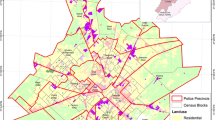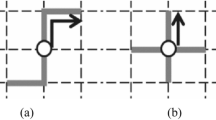Abstract
Given a spatial network and a collection of activities (e.g. crime locations), the problem of Mining Network Hotspots with Holes (MNHH) finds network hotspots with doughnut shaped spatial footprint, where the concentration of activities is unusually high (e.g. statistically significant). MNHH is important for societal applications such as criminology, where it may focus the efforts of officials to identify a crime source. MNHH is challenging because of the large number of candidates and the high computational cost of statistical significance test. Previous work focused either on geometry based hotspots (e.g. circular, ring-shaped) on Euclidean space or connected subgraphs (e.g. shortest path), limiting the ability to detect statistically significant hotspots with holes on a spatial network. This paper proposes a novel Network Hotspot with Hole Generator (NHHG) algorithm to detect network hotspots with holes. The proposed algorithm features refinements that improve the performance of a naïve approach. Case studies on real crime datasets confirm the superiority of NHHG over previous approaches. Experimental results on real data show that the proposed approach yields substantial computational savings without reducing result quality.
Access this chapter
Tax calculation will be finalised at checkout
Purchases are for personal use only
Similar content being viewed by others
References
Fitterer, J., Nelson, T., Nathoo, F.: Predictive crime mapping. Police Pract. Res. 16(2), 121–135 (2015)
Brantingham, P., et al.: Environmental Criminology. SAGE, Beverly Hills (1981)
Kulldorff, M.: SaTScan user guide for version 9.0 (2011)
Eftelioglu, E., Tang, X., Shekhar, S.: Geographically robust hotspot detection: a summary of results. In: ICDM International Workshop on Spatial and Spatiotemporal Data Mining (SSTDM) (2015)
Kulldorff, M., et al.: An elliptic spatial scan statistic. Stat. Med. 25(22), 3929–3943 (2006)
Tang, X., et al.: Elliptical hotspot detection: a summary of results. In: ACM SIGSPATIAL Workshops (2015)
Neill, D.B., et al.: A fast multi-resolution method for detection of significant spatial disease clusters. In: Advances in Neural Information Processing Systems (2003)
Eftelioglu, E., et al.: Ring-shaped hotspot detection: a summary of results. In: IEEE International Conference on Data Mining, pp. 815–820 (2014)
Grubesic, T.H., Wei, R., Murray, A.T.: Spatial clustering overview and comparison: accuracy, sensitivity, and computational expense. Ann. Assoc. Am. Geogr. 104(6), 1134–1156 (2014)
Beavon, D.J., Brantingham, P.L., Brantingham, P.J.: The influence of street networks on the patterning of property offenses. Crime Prev. Stud. 2, 115–148 (1994)
Law, J., Quick, M., Chan, P.: Bayesian spatio-temporal modeling for analysing local patterns of crime over time at the small-area level. J. Quant. Criminol. 30(1), 57–78 (2014)
Okabe, A., Okunuki, K.-I., Shiode, S.: The SANET toolbox: new methods for network spatial analysis. Trans. GIS 10(4), 535–550 (2006)
Okabe, A., Sugihara, K.: Spatial Analysis Along Networks: Statistical and Computational Methods. Wiley, New York (2012)
Shiode, S., Shiode, N.: Network-based space-time search-window technique for hotspot detection of street-level crime incidents. Int. J. Geogr. Inf. Sci. 27(5), 866–882 (2013)
Dev, O., et al.: Significant route discovery: a summary of results. In: Duckham, M., Pebesma, E., Stewart, K., Frank, A.U. (eds.) GIScience 2014. LNCS, vol. 8728, pp. 284–300. Springer, Heidelberg (2014)
Shi, L., Janeja, V.P.: Anomalous window discovery for linear intersecting paths. IEEE Trans. Knowl. Data Eng. 23(12), 1857–1871 (2011)
Costa, M.A., Assunção, R.M., Kulldorff, M.: Constrained spanning tree algorithms for irregularly-shaped spatial clustering. Comput. Stat. Data Anal. 56(6), 1771–1783 (2012)
Levine, N.: Crime mapping and the crimestat program. Geogr. Anal. 38(1), 41–56 (2006)
Kuratowski, K.: Topology, vol. 1. Elsevier, Amsterdam (2014)
Kulldorff, M.: A spatial scan statistic. Commun. Stat.-Theor. Methods 26, 1481–1496 (1997)
MacKay, D.J.: Information Theory, Inference and Learning Algorithms. Cambridge University Press, Cambridge (2003)
Us census bureau tiger/line shapefiles. http://www.census.gov/geo/maps-data/data/tiger-line.html. Accessed 9 Dec 2015
City of Chicago data portal. https://data.cityofchicago.org/Public-Safety/Crimes-2001-to-present/ijzp-q8t2. Accessed 01 Dec 2014
City of Oakland data portal. https://data.oaklandnet.com. Accessed 1 May 2016
Ester, M., et al.: A density-based algorithm for discovering clusters in large spatial databases with noise, pp. 226–231. AAAI Press (1996)
Hartigan, J.A., Wong, M.A.: Algorithm AS 136: a K-means clustering algorithm. Appl. Stat. 28, 100–108 (1979)
Oliver, D., et al.: A k-main routes approach to spatial network activity summarization. IEEE Trans. Knowl. Data Eng. 26, 1464–1478 (2014)
Guo, D.: Local entropy map: a nonparametric approach to detecting spatially varying multivariate relationships. Int. J. Geogr. Inf. Sci. 24(9), 1367–1389 (2010)
Wolfe, M.K., Mennis, J.: Does vegetation encourage or suppress urban crime? Evidence from Philadelphia, PA. Landscape and Urban Planning 108, 112–122 (2012)
Hirschfield, A., Birkin, M., Brunsdon, C., Malleson, N., Newton, A.: How places influence crime: the impact of surrounding areas on neighbourhood burglary rates in a British city. Urban Stud. 51(5), 1057–1072 (2014)
Acknowledgments
This material is based upon work supported by the National Science Foundation under Grants No. 1029711, IIS-1320580, 0940818 and IIS-1218168, the USDOD under Grants No. HM1582-08-1-0017. We would like to thank Kim Koffolt and University of Minnesota Spatial Computing Research Group for their comments.
Author information
Authors and Affiliations
Corresponding author
Editor information
Editors and Affiliations
Rights and permissions
Copyright information
© 2016 Springer International Publishing Switzerland
About this paper
Cite this paper
Eftelioglu, E., Li, Y., Tang, X., Shekhar, S., Kang, J.M., Farah, C. (2016). Mining Network Hotspots with Holes: A Summary of Results. In: Miller, J., O'Sullivan, D., Wiegand, N. (eds) Geographic Information Science. GIScience 2016. Lecture Notes in Computer Science(), vol 9927. Springer, Cham. https://doi.org/10.1007/978-3-319-45738-3_4
Download citation
DOI: https://doi.org/10.1007/978-3-319-45738-3_4
Published:
Publisher Name: Springer, Cham
Print ISBN: 978-3-319-45737-6
Online ISBN: 978-3-319-45738-3
eBook Packages: Computer ScienceComputer Science (R0)




